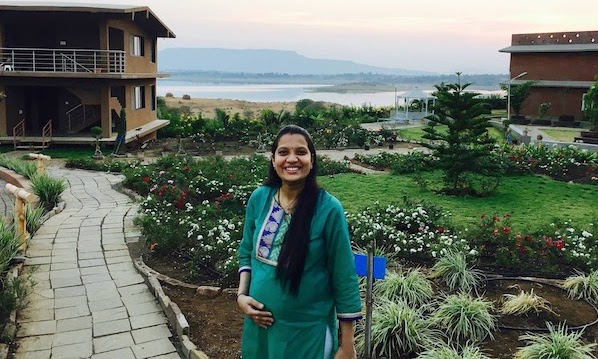
Garbha Sanskar in the 2nd Trimester

The second trimester, spanning weeks 13 to 26 of pregnancy, is characterized by substantial fetal growth, including the development of distinct facial features and the baby’s ability to move. Mothers often experience relief from early pregnancy symptoms like morning sickness, though new changes like a growing belly and feeling the baby move occur. This is a crucial period for prenatal check-ups, which monitor the health of both mother and baby. Mothers are generally encouraged to continue with healthy eating, moderate exercise, and prenatal vitamins. It’s also a time when many parents start actively preparing for the baby’s arrival, setting up a nursery, and learning about childbirth and parenting. Overall, the second trimester is often viewed as a more comfortable phase of pregnancy.
In summary, the second trimester is often a time of relative comfort, significant fetal growth, and increased anticipation as the pregnancy becomes more evident.
Garbha Sanskar is applicable to the entire 9 months of pregnancy. In the 2nd trimester, you can add certain activities to your routine such as listening to mantras, doing Garbh Samvaad, yoga, and meditation. These activities help in the mental development of the baby, make the baby more confident, and prepare the body for childbirth.
Garbha Samvad
Listen to Carnatic music and Raagas
For atleast 20 minutes everyday. Listen to Raagas.
- Month 4: during this time, mothers should listen to Gaud Sarang raaga as it increases blood circulation. Afternoons are most suited time for the same.
- Month 5: listening to Ahir Bhairav raaga in mornings is great for baby’s neural development in this phase
- Month 6: during this time, listening to Madhyavati Raaga in the afternoons helps you experience a deeper bond.
Have a daily schedule of prayers
Make a playlist of your favourite bhajans and play them. The Samaveda mantra is highly recommended. Gayatri mantra, Ganesha mantra have a beautiful impact on the baby. Balaji Tambe’s Garbha Sanskar music is quite popular among women.
Talk to your child
It helps in the mental development of the baby. It may also make your baby more confident, aware as well as quick in responding. You need to talk aloud, not just in your mind. You can narrate how your day went, how much you love the baby and also read stories.
Garbha Aahar
- Whole grains: Whole grains like brown rice, quinoa, oats, and barley are rich in fiber, which helps with digestion and prevents constipation, a common issue during pregnancy. They also provide essential B vitamins, which play a crucial role in fetal development.
- Fruits and vegetables: Fruits and vegetables are packed with vitamins, minerals, and antioxidants that are essential for the baby’s growth and development. Some particularly beneficial fruits include bananas, oranges, apples, berries, and avocados. Vegetables like leafy greens, broccoli, carrots, and sweet potatoes are also excellent choices.
- Lean protein sources: Lean protein sources like chicken, fish, lentils, and beans provide essential amino acids for the baby’s growth and development. They also help maintain muscle mass and energy levels during pregnancy.
- Calcium-rich foods: Calcium is essential for the baby’s bone development. Milk, yogurt, cheese, and leafy greens are excellent sources of calcium.
- Iron-rich foods: Iron is important for transporting oxygen to the baby. Lean meats, poultry, fish, beans, lentils, and leafy greens are good sources of iron.
- Healthy fats: Healthy fats, such as those found in avocados, nuts, seeds, and olive oil, are essential for the baby’s brain development. They also help with nutrient absorption.
Here’smonth wise diet chart suggestions:
Month Four
Advised foods: butter from Milk (saay ) approx. 10 gms / day rice with curd
- On waking up: 4 soaked almonds + 4-5 soaked black raisins + 1 cup fennel seed water
- Breakfast : Sprouted moong dal chilla with coriander mint chutney + 1 cup milk
- Mid-morning : Cut fruit salad [Apple/ pear/ Pomegranate/ orange/ watermelon/ muskmelon] + Coconut water
- Lunch: Cucumber and Carrot salad + ****Brown rice with lauki chana dal with a subzi and Buttermilk with chia seed or sabja seed.
- Early evening: Sprouted green moong salad with lemon squeezed in it
- Dinner: Dal khichdi with sauteed mixed vegetables
Month Five
Advised foods: Cow Ghee rice with milk
- On waking up: 4-5 black raisins + 2 dried figs with a glass of warm water
- Breakfast: Paneer paratha with curd
- Mid-morning: A glass of buttermilk with pinch of cumin powder
- Lunch: Rice with sambar (add mixed vegetables) + kala chana salad
- Early evening: Mixed vegetable soup with 1 medium fruit
- Dinner: Beetroot roti with any seasonal green leafy vegetable dry sabzi + stir-fried tofu with mixed vegetables
Month Six
Advised foods: lots of ghee and rice
- On waking up: Herbal ginger tea + 2 dried apricots + 2 soaked walnuts
- Breakfast: Stuffed methi paratha with plain curd
- Mid-morning: Boiled Corn and pomegranate chaat + lemonade
- Lunch: Mixed dal + beans and carrot dry sabzi + jowar roti + buttermilk
- Early evening: Chickpeas and green peas tikki with mint coriander chutney
- Dinner: Millet pasta made in pink sauce with mixed vegetables (sauce with button mushrooms, broccoli, carrot, beetroot puree)
Garbha Yoga
Have a daily schedule of yoga that helps prepare your body for childbirth. Here are some of the Yoga and exercises you can try during second trimester. Please consult with your healthcare provider and doctor before trying these. Always do them under expert supervision.
Palm Tree Pose (Tadasana)
For spina and back health
Setu Bandhasana (Bridge Pose)
For pelvic wellness, do Bridge rolls.
Malasana (Garland Pose)
As the pregnancy progresses, the baby grows and takes up more space in the uterus. This can put pressure on the bladder and bowels, leading to constipation. Malasana helps to open the hips and pelvis, which can relieve constipation and promote healthy digestion.
Baddha Konasana (Bound Angle Pose)
As the baby grows, the ligaments in the hips and thighs soften to prepare for childbirth. Baddha Konasana helps to stretch and strengthen these ligaments, which can help to prevent injury during labor and delivery.
Upavistha Konasana (Seated Angle Pose)
As the baby grows, the weight of the uterus can put pressure on the lower back. Upavistha Konasana helps to stretch and strengthen the muscles in the lower back, which can help to relieve back pain.
Trikonasana (Triangle Pose)
As the pregnancy progresses, the center of gravity shifts forward, which can lead to balance problems. Trikonasana helps to improve balance, which can help to prevent falls.
Virabhadrasana I & II (Warrior I Pose)
In the later months of pregnancy, fatigue can become a problem. Virabhadrasana helps to strengthen the legs and core, which can improve energy levels.
Do visualisation exercises during meditation
Imagine you are sitting next to an ocean. The waves are making a rhythmic sound. Baby is floating in the cadence of those sounds. Or, you are a butterfly and sipping the best nectar from many flowers and nourishing your baby.




